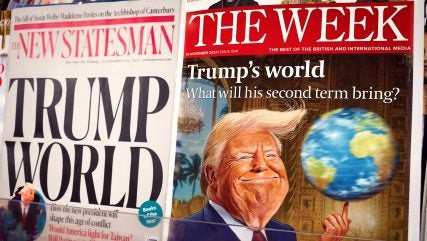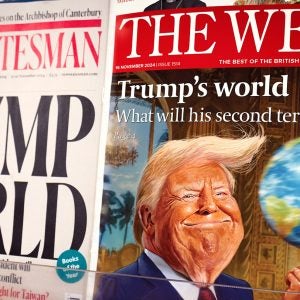
USA
UPDATED 11 April: President Donald Trump has climbed down on his controversial ‘Liberation Day’ tariffs just one week since he announced them, pausing the highest percentage impositions for 90 days. However, he more than doubled down on Chinese imports tagging them with a 125% levy. He has now upped that to 145% on some goods while most of the rest of the world incurs a 10% import tariff as of now. Where does this leave textile care businesses?
Prior to the most recent announcement from the President of the hold( via social media) on 9 April, professional associations representing the textile care industry expressed concern about the impact Trump’s tariffs would have on their members’ businesses. Trump had announced the sweeping and costly tariffs on imports from countries he perceived as having been “taking advantage” of the United States and leaving the US in a trade deficit.
Trump believes manufacturing in the US has declined because of cheap imports from many countries around the globe, and had judged the worst offenders, apart from China, to be Vietnam, slapped with a 46% tariff on its goods; Thailand, whose tariff was upped to 36%; followed by Japan which was to be levied 24% on its goods, and; the European Union which faced a 20% levy.*
However, those levies, apart from those on China, from 9 April, are now pegged at 10%, at least for the next 90 days (unless Trump does another U-turn). Meanwhile, according to a report by BBC News, “the 10% so-called baseline rate never applied to Canada and Mexico – key trading partners of the US – and a White House official has said neither is in line to receive the 10% baseline tariff now”.
The result of all this has seen global markets in turmoil, including in the US, and uncertainty about maintaining supply chains and just how, exactly, they will work now. If at all. For example, the US does not make steel anymore so it has to come from somewhere that will now incur tariffs making the manufacture of laundry and drycleaning machinery much more expensive. The impact on textile care businesses is worrying. Even at 10% the tariffs up the cost of operating competitively.
For US businesses importing form China the effects are immeasurable.
Looking for enlightenment on what all this could mean to the US textile care industry, LCNi approached Joe Ricci, president and CEO of TRSA, the professional trade association for textile rental businesses across North America, covering not only the USA but also Canada and Mexico.
He said: “TRSA represents the $50 billion linen, uniform and facility services industry, which employs 200,000+ people at 2,500+ facilities in North America.
“A significant portion of linens and textiles in the United States are imported. Tariffs directly increase the cost of imported goods. For the linen and uniform rental industry, this means higher prices for imported linens and uniforms. In 2021, the US imported textiles and apparel worth approximately $144.6 billion,” said Ricci. “The majority of these imports come from overseas countries impacted by these tariffs. Overall, more than 98% of retail clothing sold in the United States is imported.”
“In addition to impacting textiles,” continued Ricci, “the tariffs will impact our equipment manufacturers, chemical suppliers and other essential products and services that require components not available in the US. These increased costs lead directly to higher prices for consumers and reduced profit margins for businesses along with other factors have also created a very high level of uncertainty that is just bad for business. Prices for domestically manufactured products will also increase due to greater demand.
“Whether these or other tariffs are implemented or just threatened to be implemented, economic uncertainty is causing companies to pause plans for growth forcing companies to hold back, directly impacting job creation. Even the threat of tariffs will also create supply chain delays and disruptions. Businesses will need to consider their sourcing strategies. While the United States would like more things made here, because that’s good for the economy, that’s good for jobs, new tariffs will drive up the cost of actually making those things here in the United States.
“The key to having a thriving US economy is having US companies that are investing and becoming more productive. And we can’t do that because we’re uncertain about immigration, tax and trade environment.
“It should be noted, it is important to ensure that reusable textiles are treated the same as single use textiles. (LCNi will follow up with a separate report on this.) A more balanced trade policy that emphasises cooperation, open markets, and adherence to international trade rules can better serve the industry, American businesses, and consumers. The United States can establish a more consistent business environment, sustain economic growth, and maintain its leadership in the global economy by engaging with global partners and promoting fair trade practices,” said Ricci.
Meanwhile, Luci Ward, executive director, Textile Care Allied Trades Association (TCATA) which on 8 March held a useful webinar on tariffs, said: “Tariffs** on imported goods have the potential to significantly disrupt the commercial laundry and drycleaning industry. With rising costs for essential equipment, chemicals, and supplies, businesses are faced with the challenge of balancing increased expenses while maintaining service quality and affordability for their customers. The ripple effect could ultimately impact not just manufacturers and distributors, but also the broader supply chain and the communities they serve.”
At the same time, Kyle E Nesbit, Southwest Drycleaner Association (SDA) president and Dry Cleaning and Laundry Institute International (DLI) chairman, told LCNi: “I know that Tariff 232 Steel has already shot hanger prices from Mexico +17% and from China +24%. There could be more coming, but as of now this has caused us to pass on a price increase to the consumer of 2%.” Since that statement China’s tariff has been raised to 125% so more math needs to be done.
So, that is the news today, but who know where we will be tomorrow? It is the uncertainly and confusion, as much as the tariffs themselves, that are negatively impacting business and slowing potential growth, new hires, expansion and more. Watch this space.
*For some inexplicable reason Australia also appears on the list despite running a trade surplus with the US. Another odd twist is that the Heard and McDonald Islands in the sub-Antarctic, populated solely by penguins and seals – no humans whatsoever – is facing 10% tariffs. Even more baffling, Russia and North Korea are exempt.
**According to TCATA, a tariff is a tax or duty imposed by a government on imported or exported goods. It serves several purposes, including:
Protecting Domestic Industries: By making imported goods more expensive, tariffs encourage consumers to buy domestically produced products.
Raising Government Revenue: Tariffs generate income for the government, especially in countries that rely on international trade.
Balancing Trade: Governments may use tariffs to address trade imbalances or respond to unfair trade practices by other countries.
There are two main types of tariffs:
Ad valorem tariff: A percentage of the value of the imported goods.
Specific tariff: A fixed fee based on the quantity or weight of the goods.
Tariffs can affect global trade dynamics, leading to trade disputes, higher consumer prices, and shifts in the global supply chain.






